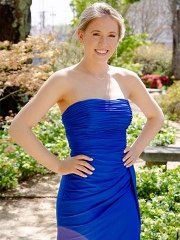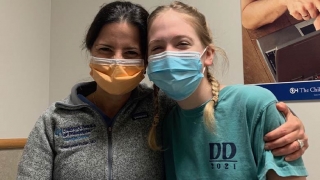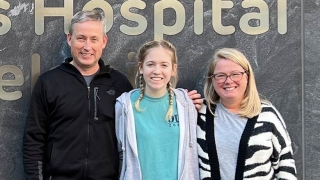Neuroendocrine Tumor: Peyton’s Story
Published on
Published on
 Peyton’s coughing didn’t seem to merit much concern. But it was actually the first symptom of a rare type of tumor, called a neuroendocrine tumor, located in her airway. As her Alabama-based family researched the best place to treat her, they had two priorities: They wanted it to be a children’s hospital, and they wanted a surgeon who would at least try to save part of Peyton’s right lung. At Children's Hospital of Philadelphia (CHOP), they found what they were searching for.
Peyton’s coughing didn’t seem to merit much concern. But it was actually the first symptom of a rare type of tumor, called a neuroendocrine tumor, located in her airway. As her Alabama-based family researched the best place to treat her, they had two priorities: They wanted it to be a children’s hospital, and they wanted a surgeon who would at least try to save part of Peyton’s right lung. At Children's Hospital of Philadelphia (CHOP), they found what they were searching for.
The cough began in January 2021. She was 15 at the time and had a history of allergies, so neither she nor her parents, Michelle and Robert, thought much about it. But by March, it had worsened, and considering the COVID-19 pandemic, it became worrisome, so Peyton went to her pediatrician. Asthma was suspected, and then pneumonia. Over the next few months, Peyton was prescribed multiple rounds of different antibiotics, but nothing helped. In July, she saw a specialist in pulmonology.
“The diagnosis process was very long,” says Robert. “We were Googling things, reading journal articles. Nothing looked like Peyton’s case.”
Then a blood test came back with elevated levels of a protein called chromogranin A, which can be released in higher-than-normal levels in people with tumors of the neuroendocrine system. “I Googled it and thought, ‘Good grief,’” says Michelle. A CAT scan verified the existence of a tumor.
“Back when she had the X-ray when they thought it was pneumonia,” Robert recalls, “there was a little note at the bottom that said they couldn’t rule out a tumor. Since that time, I had felt sure that’s what it was. It was a long, scary process.”
As for Peyton, she was just trying to be a teenager. “It was summer, and I was busy doing other things. I kept a distance from all the medical talk.”
 Peyton with Dr. Fuller
Michelle is a lawyer. “I do research for a living, so I just started looking for treatment options for children,” she says. “There are options for adults that aren’t applicable to children.” She reached out to half-a-dozen places nationwide. One institution said they didn’t have a surgeon comfortable trying to remove the tumor.
Peyton with Dr. Fuller
Michelle is a lawyer. “I do research for a living, so I just started looking for treatment options for children,” she says. “There are options for adults that aren’t applicable to children.” She reached out to half-a-dozen places nationwide. One institution said they didn’t have a surgeon comfortable trying to remove the tumor.
One person she contacted was Theodore Laetsch, MD, Director of CHOP’s Very Rare Malignant Tumors Program. That stood out, says Robert: “CHOP had a rare tumors program, and it was the only children’s hospital that specifically listed neuroendocrine tumors on the website as something they treat.”
The CHOP team, including Dr. Laetsch and cardiothoracic surgeon Stephanie Fuller, MD, reviewed Peyton’s case. “We received a call from the nurse navigator saying they have a treatment plan,” says Michelle. The family felt encouraged, but they were looking for reassurance about one thing: Several places they had previously talked to wanted to remove Peyton’s entire right lung. “We wanted a doctor who would try to do better than that.”
Shortly after the nurse navigator’s call, they received a second call that made all the difference: “Dr. Fuller called us directly,” says Michelle. “It was such a surprise. We never talked to the surgeons. She was very familiar with the case and had a proposed course of action. She also made an effort to connect with Peyton. She knew the concerns a teen would have, like the size of the scar. That meant a lot.”
 Peyton with her parents, Robert and Michelle
The family traveled to CHOP in October. “Once we got involved with CHOP, things moved quickly, and we were fine with that,” says Michelle.
Peyton with her parents, Robert and Michelle
The family traveled to CHOP in October. “Once we got involved with CHOP, things moved quickly, and we were fine with that,” says Michelle.
Part of Peyton’s evaluation included a bronchoscopy, but she had undergone that procedure over the summer as part of her diagnosis process, and it hadn’t been a good experience. “Afterward, it felt like I was swallowing glass,” she says. But at CHOP, it was a completely different experience. “They told us that they have these tiny scopes they can use,” Michelle explains. “That’s an example of why we wanted a children’s hospital.”
During Peyton’s six-hour surgery, due to the tumor’s location and size, Dr. Fuller removed two of the three lobes of the right lung. Testing of the tumor confirmed it was benign.
Peyton stayed at CHOP for a few weeks recovering from the surgery. “It took two weeks to get the chest tube out,” she recalls. When she returned to Alabama, she remained tired for weeks. “I waited until January to do any kind of physical activity. At the time, I was involved in cheer, and when I went back, at first it was a struggle to catch my breath. But I could tell I was getting better. Each practice got better.”
Now, almost two years after the surgery, she’s an active high school senior. “I’m a little limited. Me and my brother used to compete holding our breath under water. Now he beats me.”
She loves reading and playing with her dog, Linus, and is busy filling out college applications in the hope of studying chemistry. “The biggest thing for me this year isn’t sports or music. I’m Student Government president. I have a lot of ideas!”
“We cannot say enough positive things about CHOP,” says Michelle. “All the people, the nurses — it was fantastic!”